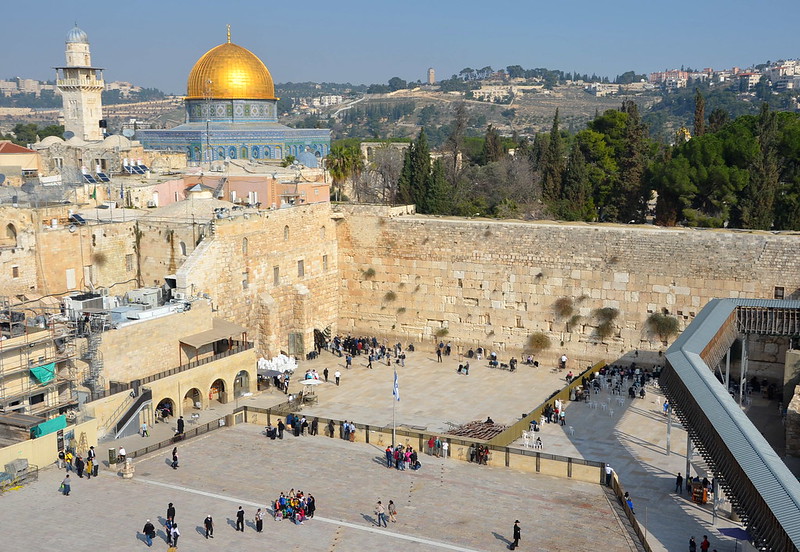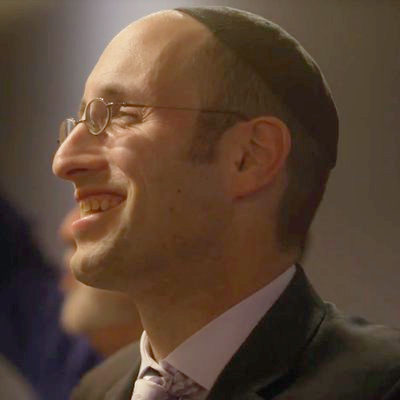The Real Truth About the Temple Mount
For Yair Lapid "to say on television that the Western Wall is Judaism's holiest site is to provide propaganda to those who seek to negate the Jewish connection to Jerusalem."

What is Judaism’s holiest site? It is a simple question with an obvious answer. Thrice daily, Jews pray for the restoration of sacred service to Jerusalem’s Temple Mount. It is toward this location that all Jewish prayers have been poured out since the Temple was destroyed. The Mount is the only area on earth where, according to a Jewish law, certain parts cannot be entered in a state of ritual impurity, and many traditional Jews have refrained from ascending to the site lest they violate Jewish law.
Yet many now believe that, with a knowledge of the layout, history, and religious laws pertaining to the location, it is permissible to visit certain parts of the Temple Mount Plaza. They do so under religious guidance, immersing first in a ritual bath, or mikvah, in order to commune with the God they believe still dwells at what is unquestionably Judaism’s holiest site.
In doing so, however, they have still been forced to abide by the “status quo” established by Moshe Dayan in the aftermath of the 1967 Six-Day War. Religious authority over the area is largely exercised by the Muslim waqf, and visiting Jews are literally forbidden to pray. Despite this indignity, religious Jews have continued to come, recently by the many thousands. One of the most popular days of the year to visit is the Ninth of Av, when the Temple was destroyed. The Temple’s destruction is the reason that this day is the saddest of the Jewish calendar, because—obviously—the Temple Mount is Judaism’s holiest site.
It was on the Ninth of Av this year that rioting Arabs sought to prevent Jewish visitation. They failed. In a published statement, newly installed Prime Minister Naftali Bennett “thanked the public security minister and the Israel Police [chief] for managing the events on the Temple Mount with responsibility and consideration, while maintaining freedom of worship for Jews on the Mount.” His words were immediately scoured for meaning. Did the prime minister intend to imply that now Jews would have freedom of prayer on the Mount? After all, his language highlighted a striking fact: that in the Jewish state, the only faith members who cannot worship at its holiest site in the country are the Jews. Could this ultimate inequity suddenly disappear?
But soon after, the prime minister’s office issued a statement amending Bennet’s original one, and Yair Lapid—who is not of Bennett’s party and does not share his ideological or religious convictions—assured the Kingdom of Jordan that no change in the status quo would take place. Then Lapid went further. “Jews have freedom to visit Temple Mount and Muslims have freedom of worship there,” he said. “If Jews wish to pray, the holiest place for Jews is a few meters from there—the Western Wall.”
This is preposterous. The Western Wall, or “Kotel,” is the retaining wall of the Temple Plaza from the Herodian age. It acquired its special status because it was the one site where Jews were allowed by the Ottomans to gather in yearning for the Temple itself, and to mourn its destruction. The Kotel is the place where Jews for centuries gathered…to affirm that the Temple Mount is Judaism’s holiest site.
Worse was yet to come. What began as an inelegant attempt at diplomacy would soon descend into farce. Meirav Ben-Ari, a member of Knesset and of Lapid’s Yesh Atid Party, was asked on Israeli television about Lapid’s comments. “Is it also your opinion,” queried the journalist “that the Kotel is the holiest site for Jews?”
“Barur,” she crisply replied—“but of course.” The interviewer pressed: “Not the Temple Mount?” Ben-Ari reiterated her party leader’s line: “The Kotel is the holiest site for the Jewish people.” Again, following up, the interviewer asked: “More than then the Temple Mount?”
“Ani lo osah taharut,” Ben-Ari said, which means: “I am not making a competition.”
It is not clear, or course, what this signified. Does Ben-Ari believe that the Kotel is Judaism’s holiest site, or doesn’t she? As the puzzled reporter asked how Ben-Ari could ignore “our fundamental history as a people,” she stuck by the party leader’s line: “Zo daati vezo amadati.” Meaning: “This is my opinion and this is my position.”
The application of this fascinating phrase to denying historical fact—my opinion and my position—comes perilously close to the postmodern penchant for “speaking one’s truth.” Thus did a politician—who is not a historian, theologian, or Judaic scholar of any kind—summarily redefine the Jewish faith. Thus was the Ninth of Av followed by governmental figures denying all that Jews have mourned on that day.
Ultimately the problem with statements such as these is not their ignorance but that they give ammunition to enemies of Israel, who seek to lie about Jewish history. The hard truth is that in the past 54 years since the miraculous moment when Jews returned to ancient Jerusalem, the sacred city has itself been rebuilt—but the destruction of the remnants of the Temple has gotten worse. The waqf has destroyed much archeological evidence of the Temple that once was there, and many Palestinian leaders have denied that the Temple stood there in the first place. To say on television that the Western Wall is Judaism’s holiest site is to provide propaganda to those who seek to negate the Jewish connection to Jerusalem.
The episode is another reminder that the Jewish return to Jerusalem in 1967 marked one of the most miraculous moments in the history of the Jewish people, but it is also the anniversary of Israel’s greatest mistake. The victory in the Six-Day War could have been a moment to establish what Prime Minister Bennet rightly called “freedom of worship” on the Mount, a moment to enshrine the right for Jews to pray there as much as Muslims. But that moment was missed by Moshe Dayan, and the situation is very different today.
For those who care deeply about the Jewish connection to the Mount, and who desperately desire to pray there, it may well be that today it will be achieved first and foremost with finesse. A recent Israeli news report described how Israeli police are allowing visiting Jews on the Mount to pray—to do so quietly, unofficially, without the usual accoutrements such as prayer shawls and phylacteries, but to pray nonetheless. One of the unsung heroes of the surreptitious step forward seems to be Gilad Erdan, the outgoing Israeli ambassador to Washington, who will be staying on as Israel’s representative in the UN. Until recently the Israeli police atop the Mount would stop any Jewish act that came close to prayer, at times protesting even if a tour guide quoted the Bible. But the Jerusalem Post described how Erdan, while serving as Israel’s minister for public security, deliberately oversaw personnel changes to the police, ensuring that they “softened their attitude to Jewish visitors and did not remove those engaged in small, discreet Jewish prayer services from the site.”
Meanwhile, the government of Israel owes it to its citizens, and thousands of years of Jewish history, to state unequivocally that the Temple Mount, and not the Western Wall, is the locus of Jewish longing. It is not difficult to acknowledge, and it is important to do so for many reasons, but for one above all: It is true. And as long as lies and ignorance persist about the Jewish relationship with the Temple Mount, Jewish visits to what is undeniably Judaism’s most sacred site will become more important than ever.
This essay was originally published in Commentary.
Someone tell Yair Lapid that the Western Wall is Judaism's holiest site.
Someone tell Yair Lapid that the Western Wall is Judaism's holiest site.

